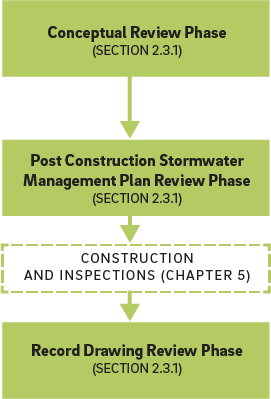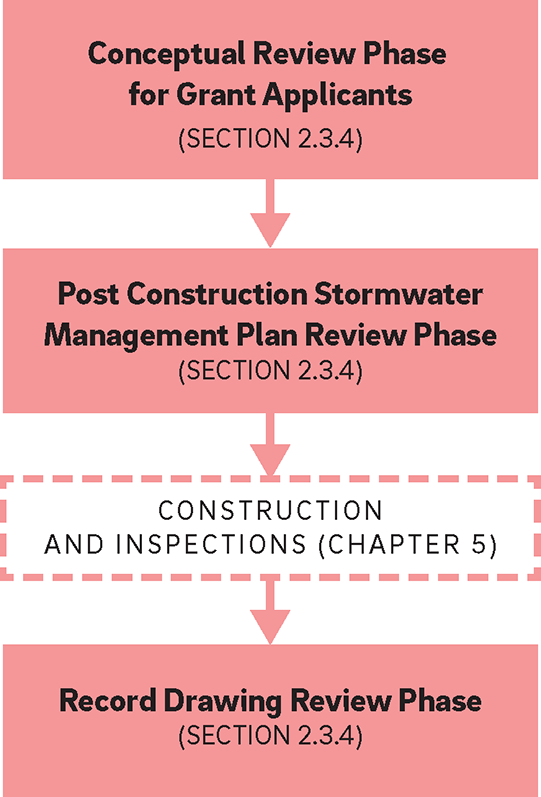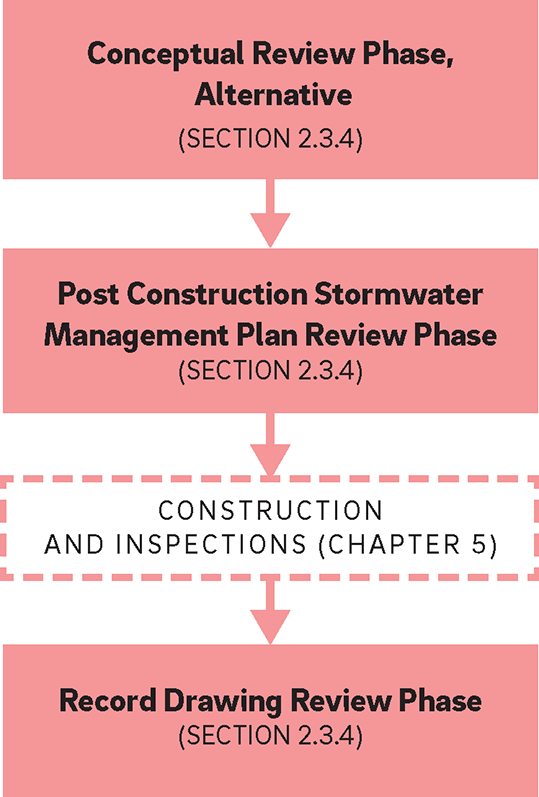Section 2.2 describes each of the four Review Paths to demonstrate a project’s compliance with, or exemption from, the Philadelphia Water Department (PWD) Stormwater Regulations (Stormwater Regulations), including the steps, or Review Phases, within each Review Path. Each Review Path has its own individual set of requirements and criteria for approvals.
Once a project’s Review Path is identified, the applicant must follow the steps in this Section that correspond with the color-coded Review Path. Because some of the steps between Review Paths are identical, there is some repetition in the descriptions below. The applicant need only refer to the set of steps corresponding to the project’s determined Review Path.
Each project will follow one of the four following Review Paths:
| Development Compliance – Section 2.2.1 |
| Development Exemption – Section 2.2.2 |
| Demolition – Section 2.2.3 |
| Stormwater Retrofit – Section 2.2.4 |
If the proposed limit of earth disturbance for the project changes at any point in the development process, the applicant must refer back to Section 2.1.2 to confirm the project’s Review Path.
Projects may be subject to State or Federal permit requirements, or other PWD requirements aside from the Stormwater Regulations. It is the applicant’s responsibility to determine whether their project must comply with other PWD, City, State, or Federal permit requirements. The applicant is referred to Section 2.5, Section 2.6, and Section 2.7 for more information. If uncertain about how to proceed, the applicant is encouraged to contact Stormwater Plan Review at any point during the submission and review process.
2.2.1 Development Compliance Review Path
The majority of development projects reviewed by Stormwater Plan Review fall into the Development Compliance Review Path and are subject to Post‑Construction Stormwater Management (PCSM) Requirements (Section 1.2.1). PCSM Requirements apply to most projects that propose 15,000 square feet or more of earth disturbance (5,000 square feet or more in the Darby and Cobbs Creek Watershed). Stormwater Retrofits may have earth disturbance above 15,000 square feet and not be required to meet Stormwater Regulations.
The Development Compliance Review Path includes three Review Phases, as detailed in Figure 2.2‑1.
Figure 2.2‑1: Development Compliance Review Path Flow Chart

Projects in the Development Compliance Review Path must obtain both Conceptual and Post‑Construction Stormwater Management Plan (PCSMP) approvals from Stormwater Plan Review. Section 2.3 provides detailed submission requirements for projects in this Review Path.
For the Development Compliance Review Path, PWD offers incentives to developers proposing the use of disconnected impervious cover (DIC) and green stormwater practices, such as bioinfiltration/bioretention basins and green roofs, by providing Expedited PCSMP Reviews. To determine if a project qualifies for one of PWD’s Expedited PCSMP Reviews, the applicant is referred to Section 2.4. The applicant must clearly state the intent to qualify for an Expedited PCSMP Review in the Conceptual Review Phase submission (Section 2.3.1).
If, during the course of construction, additional area is disturbed which changes the applicable requirements, the applicant must notify PWD and other appropriate agencies immediately. PWD often observes earth disturbances in the field that exceed initial estimates provided on plans. To avoid costly delays, change orders, and enforcement actions, PWD recommends that the applicant be conservative when estimating the disturbance area at each stage of the review process.
2.2.2 Development Exemption Review Path
The Development Exemption Review Path applies to most development projects with earth disturbances that are less than 15,000 square feet. Projects with earth disturbances of 5,000 square feet or more in the Darby and Cobbs Creeks Watershed should follow the Development Compliance Review Path (Section 2.2.1). Certain projects with earth disturbances greater than 15,000 square feet may still fall into the Development Exemption Review Path if the earth disturbance activities do not count toward the regulatory disturbance threshold (Section 1.1.3). The review and approval process for projects in the Development Exemption Review Path takes place in a single Review Phase. Specifically, the applicant will need to prepare a Conceptual Review Phase submission where PWD can review the proposed limits of disturbance (LOD) and verify that an Erosion and Sediment Control (E&S) Plan has been developed for the project. At the conclusion of the Conceptual Review Phase, all projects in the Development Exemption Review Path will be issued a Conceptual Approval Letter from Stormwater Plan Review. The Conceptual Approval Letter can be used as a Zoning Permit prerequisite. For most projects, the applicant can also use the Conceptual Approval Letter to satisfy their Building Permit prerequisite requirements, except for projects over one acre of earth disturbance, which may also require review from the Pennsylvania Department of Environmental Protection (PA DEP) (Section 2.7). Once the Development Exemption Review Path is complete, the applicant can proceed to construction upon receipt of their Building Permit.
If, during the course of construction, additional area is disturbed that changes the applicable requirements, the applicant must notify PWD and other appropriate agencies immediately. PWD often observes earth disturbances in the field that exceed initial estimates on plans. To avoid costly delays, change orders, and enforcement actions, PWD recommends that the applicant be conservative when estimating the disturbance area at each stage of the review process.
2.2.3 Demolition Review Path
Many development projects may have a demolition component; however, the Demolition Review Path applies only to projects that are limited to the razing or destruction, whether entirely or in significant part, of a building, structure, site, or object (including the removal of a building, structure, site, or object from its site or the removal of destruction of the façade or surface), when no redevelopment is planned. If redevelopment is planned, the applicant may choose to submit an Existing Resources and Site Analysis (ERSA) Application (Section 2.1) limited to the demolition phase of work, allowing demolition to begin prior to completion of the Development Compliance or Development Exemption Review Paths. Applicants who wish to proceed with this option are advised to contact Stormwater Plan Review prior to making this additional ERSA Application submission.
In most cases, if the demolition activity will result in less than 15,000 square feet of earth disturbance (5,000 square feet in the Darby and Cobbs Creeks Watershed) the review and approval process takes place in a single Review Phase. Specifically, the applicant will need to prepare a Conceptual Review Phase submission where PWD can review the LOD and verify that an E&S Plan has been developed for the project. At the conclusion of this Conceptual Review Phase, PWD will issue a Conceptual Approval. The Conceptual Approval Letter can be used as a Zoning Permit prerequisite. For most projects, the applicant can also use the Conceptual Approval Letter to satisfy their Demolition Permit prerequisite requirements, except for projects over one acre of earth disturbance, which may also require review from PA DEP (Section 2.7). Once the Development Exemption Review Path is complete, the applicant can proceed to demolition upon receipt of their Demolition Permit.
If, during the course of demolition, additional area is disturbed that may change the project’s Review Path or trigger additional stormwater management requirements, the applicant must contact PWD immediately to determine whether the current Review Path is still valid. PWD often observes earth disturbances in the field that exceed initial estimates on plans. To avoid costly delays, change orders, and enforcement actions, PWD recommends that the applicant be conservative when estimating the disturbance area at each stage of the review process.
If the project requires a full Building Permit, the applicant must contact Stormwater Plan Review to determine if a different Review Path is more appropriate for the project.
2.2.4 Stormwater Retrofit Review Path
The Stormwater Retrofit Review Path is administered by Stormwater Billing and Incentives to evaluate stormwater management designs proposed on private property for a purpose other than regulatory compliance (e.g., voluntary installations). An applicant who submits in the Stormwater Retrofit Review Path is typically looking to install stormwater management practices (SMPs) on their site to reduce their monthly stormwater bill, often with the assistance of PWD Stormwater Grants. Other voluntary installations may be motivated by other City incentives, triple bottom line benefits, or completing Regulations-exempt development work. For additional guidance on Stormwater Retrofit projects, the applicant is referred to Section 1.3.
Quick Tip
Stormwater Billing and Incentives can be reached at (215) 685-6070 or
pwd.stormwatercredits@phila.gov
Stormwater Retrofit projects that are awarded Stormwater Grant funding should follow the Stormwater Retrofit Review Path Flow Chart for Grant Applicants (Figure 2.2‑2). Other Stormwater Retrofit projects that are not awarded Stormwater Grant funding, as well as Stormwater Grant projects that vary considerably from their approved Stormwater Grant Application, should follow the Stormwater Retrofit Review Path Flow Chart, Alternative (Figure 2.2‑3), and its applicant should contact Stormwater Billing and Incentives as soon as possible. The applicant is referred to Section 2.3.4 for more information on the different Conceptual Review Phases for the Stormwater Retrofit Review Path.
Figure 2.2‑2: Stormwater Retrofit Review Path Flow Chart for Grant Applicants

Figure 2.2‑3: Stormwater Retrofit Review Path Flow Chart, Alternative

If a project is for a purpose other than voluntary stormwater management, or if a project involves a development or demolition component, the applicant should contact Stormwater Billing and Incentives to confirm that they are proceeding through the correct Review Path.
The applicant is encouraged to meet with PWD early in the Stormwater Retrofit decision-making process to help determine eligibility for financial assistance through its Stormwater Grant Program.